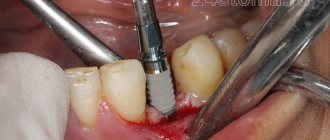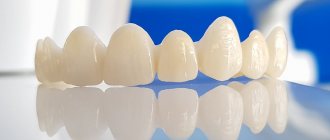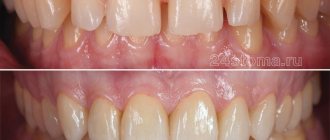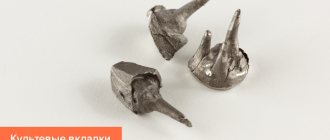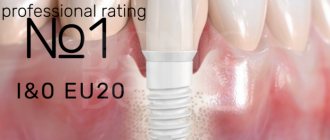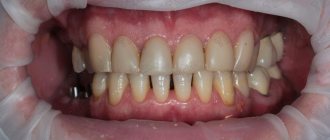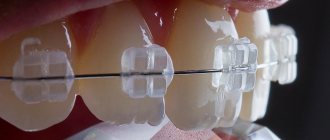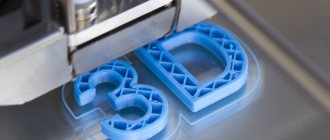Time.
Almost all types of zirconium are sintered in two hours at a temperature of 1450 to 1550 degrees. This rule applies to materials from any manufacturer. According to the standard, sintering takes approximately eight hours, of which the zirconium is gradually heated during three hours, and gradually cooled during the same time. This program is used to create small bridges and single crowns.
For large structures with stabilizers (special supports that prevent the product from deforming during sintering), a long program is used, approximately 18 to 20 hours. The scheme is the same: two hours at peak temperature, and still time for slow heating and cooling. For volumetric structures, rapid sintering is fraught with deformation and the appearance of cracks.
There is also a quick cycle lasting from one to two hours. At the same time, the temperature increases sharply; thirty minutes are allotted to the maximum mode, followed by rapid cooling. To speed up the latter, a smooth opening of the stove is provided. This method cannot be called standard; moreover, it implies restrictions on the length of the structure (up to three units). Added to this is the likelihood of nuances associated with the color and transparency of zirconium.
Zirconium dioxide sintering
Not everyone knows that zirconium dioxide requires a sintering process after milling. Only after this process does zirconium acquire those properties that made it popular in prosthetics. The editors of the DentalGEEK portal decided to look into this issue and clarify what technological features are present in this process.
It is known that the strength of zirconium can reach 1200 MPa and milling such a strong material is very difficult and expensive. Therefore, all milling of dental frames occurs from blocks of pressed zirconium dioxide powder, which is easy to process, but requires a sintering process.
1. Initial data from the manufacturer.
Today, there are quite a large number of manufacturers of zirconium dioxide blocks and disks for dental cad cam systems. Each manufacturer uses its own raw materials and specific production technology. Therefore, the characteristics of materials from different manufacturers may differ from each other. Before you start milling, you need to check the expansion coefficient (scael) of the material used, which is usually indicated on the block or disk itself, and read the instructions from the manufacturer.
2. Features of zirconium dioxide milling.
Taking into account these extensions (scael), the cam program calculates a file for milling that is approximately 20-25% larger than the original dimensions. It is for this reason that the correctness of the scael parameters guarantees the accuracy of the future design.
3. Preparation for sintering.
After milling, the frames are cut from the disk and processed. Since in most cases zirconium dioxide materials are pure white, the frames are painted in the color of the future structure, corresponding to the natural color of the individual patient. Processing and staining of zirconium should be carried out using clean gloves and under sterile conditions.
After painting, the frames must be dried so that the structure does not contain moisture. This can be done using a lamp, a special hair dryer, oven and sintering oven. If the workpiece is not dried and a full sintering cycle is started, then microcracks may appear in the frame, which will lead to the destruction of the structure.
4. Sintering.
Each manufacturer recommends a specific program for sintering their zirconium. Some manufacturers offer short programs starting at 90 minutes, while others offer standard and long programs. A typical program cycle with cooling interval can range from 9 to 12 hours. Opaque and translucent zirconium use different temperatures, so baking them together is not recommended. Before starting, check that the program in your sintering oven is correct. The best choice of a sintering furnace for your zirconium sintering laboratory will be one that is programmable for different temperature conditions.
For sintering you will also need a cup and special balls for placing dental frames on them. This is necessary for the zirconium compression process. During sintering, the balls compensate for the adhesion of the frame to the surface and make it possible to easily achieve the required dimensions and maintain the shape of the structure.
The process of processing and sintering of zirconium dioxide is very high-tech and requires careful adherence to technological steps.
The copyright for the text material on this site belongs to
DentalGEEK © DigitalStom LLC, 2014
Author: DentalGEEK —
Selection of oven and heating elements.
The most popular furnaces are furnaces with SiC (silicon carbide) and MoSi2 (molybdenum disilicide) heating elements. In the first case, these are the most budget models, but have a number of disadvantages. These include increased sensitivity at work, intolerance to sudden temperature changes and the inability to speed up the process. If such an oven is opened when it is not completely cooled, cracks may appear or it may become deformed. The operating temperature of SiC is lower than that of MoSi2. In such furnaces, you should also not use acid-based dyes for zirconium.
If you want to avoid technical problems from distracting you from your work, pay attention to stoves with MoSi2 heaters. Their surface is protected by a layer of silicon from oxides formed during heating, which makes the elements more reliable in operation. An additional advantage is that as a result, the color of the material does not suffer during processing.
Recommendation:
During prolonged operation at low temperatures, the silicon layer is quickly destroyed. To restore it, it is recommended to turn on the “cleaning” cycle at maximum heating. MoSi2 furnaces are capable of operating in extreme conditions for fast sintering. To allow the elements to cool faster, the oven door can be opened. IMPORTANT! The fast cycle requires the use of a special cup that can withstand sudden temperature changes. The standard one may burst.
The price of furnaces with MoSi2 elements is not much higher than the price of SiC furnaces. We also recommend purchasing equipment care products, the cost of which starts from 25 euros and depends on the volume. For example, pay attention to nacera clean from Doceram. They are needed to improve the process of purification from oxides. This is an important point, because Removing foreign substances and restoring the protection layer of heating elements improves the quality of processing, preventing color changes or loss of translucency of products.
One of the most important features is the presence of Tungsten in the heating element. This strengthens and gives reliability to the heating elements by an order of magnitude, while eliminating the problem of zircon turning yellow after sintering, which occurs after 1-2 years of operation of those furnaces that do not contain Tungsten! Therefore, it is advisable to choose stoves with heating elements that contain tungsten.
Technical features of zirconium as a dental material
Zirconium dioxide (ZrO2), or simply zirconium, is a white crystalline zirconium oxide. Currently, it is the most studied ceramic material in dentistry. Many specialists are introducing this material into their practice, with varying degrees of success. The main question that all experts are now asking is: is the use of zirconium a new trend or a temporary fad?
Will it be used for a long time or, as has happened more than once, will it give way to other, more modern materials? To answer this question, it is necessary to study the restoration properties of zirconium. Below are the results of observation of 15 thousand zirconium monolithic structures in the form of various restorations, from full-arch prostheses to single implants and abutments.
Structural stability
Tetragonal zirconium (after sintering) is stronger and more durable than metal. At the same time, it does not have significant flexible properties and is more susceptible to splitting than deformation. These properties can be used well in dentistry, and especially in implantology.
The key to producing a quality zirconia restoration is high precision. If the technician follows the instructions, the resulting restoration will fit better and the non-flex properties will ensure longevity. This is especially important for implant-supported restorations, since passive fit is of great importance for the effectiveness and durability of their service due to the complete immobility of the implants (Fig. 1 a, b).
Rice. 1a Fig. 1b
Zirconium does not deform under pressure, which often affects the structure during medical and dental procedures, and also conducts heat poorly.
This allows for the creation of large restorations that will not change shape in a ceramic kiln in the same way as traditional metal-ceramic restorations. The maximum operating temperature of zirconium exceeds the temperature in standard ceramic furnaces, which ensures stability and shape retention even after sintering several layers of ceramics (Fig. 2 a - c).
Rice. 2a Fig. 2b Fig. 2v
Quality aesthetics
Uncolored tetragonal zirconium is usually white in color and has a transparency similar to that of dental hard tissue. In the last few years, a more transparent material with less aluminum has become available. The final appearance of zirconia restorations is influenced by various staining fluids, staining and sintering technologies.
However, in general, zirconia restorations, especially monolithic ones, can provide excellent results in terms of esthetics without compromising their strength (Fig. 3 a, b).
Rice. 3a Fig. 3b
In the case of a veneered zirconia structure, the base structure forms the bulk of the structure and is durable, requiring only minimal use of veneers to impart color and the addition of pink gingival porcelain (Fig. 4 a, b).
Rice. 4a Fig. 4b
The lingual surfaces and the inner surface of the pontic can be left completely unlined, since nothing needs to be hidden, as is the case with a metal frame, for example.
Monolithic zirconia restorations also provide good esthetic results in limited spaces, not as a compromise, but as a good esthetic solution where this would not have been possible in the metal-ceramic era (Fig. 5 a - d).
Rice. 5a Fig. 5b Fig. 5c Fig. 5g
Monolithic zirconia also provides conservative preparation.
For good aesthetics, the preparation volume should be approximately 1 mm of tissue. This gives the specialist the opportunity to preserve much of the original tooth structure, which is especially important in the case of intact teeth.
Today, zirconium materials are at the same stage of development as ceramics were in the 70s. twentieth century - in its embryonic state. The more they are studied and used, the faster they will develop and the faster an even better aesthetic result will be achieved.
Biological compatibility
The properties of zirconium, which are explained by its atomic bonds, make this material quite biocompatible. The high density (can reach 6.1 x 10? kg/m?) and high chemical resistance ensure low bacterial accumulation on monolithic parts of the restoration, even in conditions of poor oral health.
Good wear resistance guarantees a high degree of survival of the restoration. According to several orthopedic dentists in our area, some patients with bruxism who wore monolithic zirconium restorations, after some time, stop experiencing the symptoms of this pathology or feel them less, and this is precisely due to the high wear resistance of zirconium, which deprograms bruxism. This statement has not yet been confirmed by clinical trials, but now it sounds logical, and it can be heard from more and more doctors.
The low coefficient of friction makes monolithic zirconia restorations safe for opposing teeth. Despite its hardness, zirconia (especially solid polished zirconia) is non-abrasive, and recent research in the field indicates that, of the many restorative materials, solid zirconia is the safest on opposing teeth, and in some cases even safer than natural enamel.
Rice. 6a Fig. 6b Fig. 7a Fig. 7b Fig. 7c Fig. 7g
Ease of introducing modern digital technologies into the restoration process
Dental clinics and laboratories have already entered the digital age. Many procedures can already be carried out using digital technology, and their number is increasing every year. It so happened that for the first time the production of zirconium restorations became possible in digital form. As digital technology advances, CAD systems for zirconia restorations remain at the cutting edge.
This makes it easy to integrate these technologies into the manufacturing process of zirconia restorations - from planning (digital computed tomograms), virtual impressions and design (oral scanners) to monitoring the patient’s medical record (storing and sharing files related to the patient’s medical history).
In addition, digital technology simplifies the fabrication of zirconia restorations. The best illustration is the ability to digitally replicate an exact replica of a temporary restoration that satisfies the needs of both clinician and patient, and to create an exact replica of a definitive zirconia restoration with a predictable outcome.
Despite the numerous positive aspects of the material, many doctors have difficulty introducing zirconium into their own practice, and the reasons for this are clear.
The fact is that when zirconium was just gaining popularity, in restorations it was combined (like metal) with ceramics, sometimes even according to the same rules.
There is no chemical bond between zirconium and ceramic, so these restorations often chipped and cracked almost immediately after installation. This has forced specialists to use zirconium more carefully.
Currently, to circumvent this problem, many doctors resort to the use of monolithic zirconia restorations. Creating monolithic or minimally veneered zirconia restorations requires learning new skills (especially for dental technicians), and these skills are not limited to just the ability to work with digital technologies. In-depth knowledge of the material is a key factor in creating effective zirconia restorations. Minimal adjustments, the use of a water turbine, and varying degrees of cooling and heating in ceramic ovens are just a few of the skills that dental technicians must learn.
The second reason zirconium has been so slow to be integrated into dental practices is the lack of formal training in its use. In the age of the Internet, zirconium as a dental material has gained incredible popularity thanks to online advertising, but researchers in this field have lagged far behind.
Long-term clinical studies that began 5 years ago were outdated before they were published. Statistics regarding metal-ceramics do not provide clear conclusions in favor of choosing monolithic zirconium restorations. Due to the lack of clinical studies, many doctors are reluctant to popularize the material openly, even though they use zirconium in their practice. On the other hand, companies selling similar products further confuse doctors with slogans like “the only material that will give you the results you need.”
However, they have neither scientific evidence nor instructions regarding achieving this “necessary result.” The lack of formal educational programs creates a lot of misconceptions, for example that zirconium breaks down at low temperatures and has pronounced abrasive properties. None of these ideas are true, but they have all made experts suspicious of zirconium. No manuals have been produced on how to use the material, and it is unlikely that anyone will find a seminar or course that is not associated with a specific vendor or product. The result is that many people use zirconium, but no one is aware of its properties.
In conclusion, I want to say that, having worked for 7 years and installed about 15 thousand monolithic zirconium restorations, I am sure that zirconium is here for the long haul. Quite possibly, this is the material that every dentist dreams of. It can satisfy both the patient’s requirements - “without metal and grayness”, and the doctor’s requirements for strength, durability and aesthetics.
Without a doubt, zirconium will soon become one of the most widely used materials. All that is now needed for the successful introduction of zirconium into dental practice is the creation of training materials for specialists.
Temperature
The recommended parameters are set when programming the oven. Zirconium dioxide crystals expand during sintering, which significantly affects their light transmittance. The larger they are, the less light is reflected from the crystal faces in the crown. If you create a certain pressure and set the temperature to 2200-2300°C, the result will be cubic zirconia, with transparency resembling diamond.
In the usual version, heating for zirconium is about 1450-1550°C. The higher the temperature, the more transparent it becomes. But this feature also has a downside: due to the appearance of microscopic voids between the crystals, the structure becomes less durable. Thus, if when heated to 1450 °C the strength of sintered zirconium is approximately 1200-1400 MPa, then after increasing the mode to 1600 °C it decreases to 1000 MPa or more.
From all of the above, we can conclude that even in laboratories and small centers it is impossible to do without several ovens. First of all, in order not to interrupt the work process. So, when sintering a horseshoe (occurs within 18 hours), the remaining work will have to be delayed for a day.
You can insure yourself against unnecessary or unexpected expenses when buying a stove if you take into account a number of nuances in advance. For example, you need to immediately find out the cost of replacing heaters that have a certain service life.
Well-known large manufacturers offer their products on the market at prices ranging from 8,000 to 12,000 euros, with heating elements costing 400-500 euros per piece. It's easy to calculate the costs, especially when you consider that one oven may require 4 to 6 units. heating elements. You can find high-quality stoves with optimal operating characteristics and reliable assembly within 6,000 euros, where heaters cost from 150 to 250 euros. Some companies use both options.
Sintering process
This process changes and transforms the structure of the material using pressure and thermal energy into a denser form. Moreover, after this process, the transparency (translucency) and strength of the material are improved.
The crystalline structure of zirconium dioxide, monoclinic and chalk-shaped, is obtained after preliminary sintering.
To achieve a polytetragonal structure, it is necessary to place the material at temperatures up to 1200 degrees. Zirconium dioxide takes on a harder and more durable form.
To prevent the shrinkage process of zirconium dioxide during sintering, before moving into the furnace, the material is placed in a crucible filled with ZrO2 beads.
Each manufacturer has certain settings for the process of sintering zirconium in a furnace; they must be followed to obtain a quality product. These settings are included in the sintering program and contain instructions for temperature conditions and time intervals.
Different forms of zirconia, such as translucent and opaque, are sintered separately. Therefore, before starting the process, make sure that the program is installed correctly. Dental laboratories working with zirconium dioxide choose sintering furnaces that can be set to different temperature conditions.
